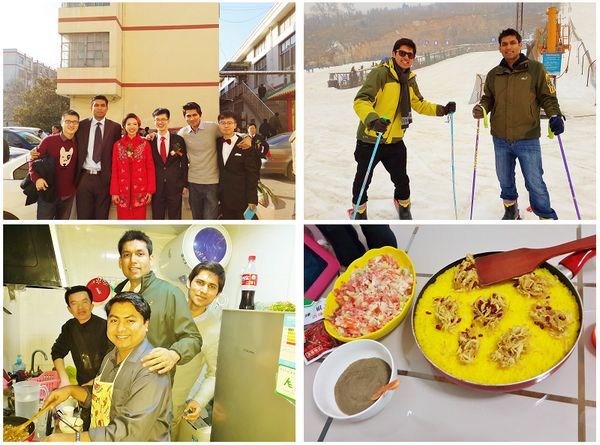
The sounds of crackers were in the air, and everyone was greeting each other “guo nian le”, "bai nian le”, "chun jie kuai le”, which means “It’s the Spring Festival”, “Best wishes for the Spring Festival” and “Happy Spring Festival”. The Spring Festival is the Chinese New Year. Everyone is happy, many shops are closed, and my younger brother Ali asked me, “Where do the Chinese people go? Do they celebrate the Chinese New Year on another planet?" I had no answer to his question. And suddenly that evening, the sky erupted with fireworks, lighting up the night sky and setting a mood for celebration. Different from the festivals in other areas, these fireworks in Chinese New Year have a special name and sound, “bian pao”, Chinese Firecracker. Chinese people sit in front of the TV on the eve of the Spring Festival, and it is one of the important elements of the festival that all the family members get together on the Spring Festival’s eve. And there is the largest migration of Chinese in modern times during holidays of the festival, which is in a very civilized manner.

People are standing in lines in the station to wait for the train, someone is riding a motorbike in the extremely cold weather, and some people have gone back home in advance, days before the Spring Festival, but it is all about reunion. This year I spent my new year with my friends in Xi’an, I thought it would be easy to get a train ticket, but to my disbelief, obtaining a train ticket proved to be extremely difficult. All tickets had been sold out. I logged into the 12306.cn and persisted in waiting for someone to refund ticket. Luckily I got one berth. I jumped on the train a night before the New Year and fortunately made it to Xi’an in time.

Now here I want to tell you about the five elements of the Spring Festival.
Spring Couplets
On the Spring Festival, families in China decorate their front doors with poetic couplets of calligraphy written with fragrant ink, expressing the feeling of life's renewal and return of spring. I also bought some couplets and decorated my room with them.
Red Packets
Giving Hongbao (red packets or red envelopes) during the Spring Festival is another tradition. A red packet is simply a red envelope with gift money in it, which symbolizes luck and wealth. Red packets are typically handed out to younger generations by their parents, grandparents, relatives, close neighbors, and friends. Red is a lucky color in China and Chinese believe it will bring good luck to the person who receiving the present. Last December, my friend Liang Benjia and I attended my friend Gao Huijie’s wedding and gave Hongbao.
Firecrackers
Traditionally, people set off firecrackers to frighten away ghosts and monsters so that the Monster “Nian” would be free of them. In order to keep the environment healthy and clean, this year I followed my friends and did not set off firecrackers. As I think the Monster “Nian” has fled and will not come back.
Dumplings
People usually eat Jiaozi (dumplings), which are shaped like crescent moons. It is said that dumplings were first cooked in China some 1,600 years ago.The Chinese pronunciation of Jiaozi means midnight or the end and the beginning of time. This year I spent my new year with my friends. It was nice, especially the art of making dumplings. The spring couplets, red envelopes and dumplings keep the essence of the Spring Festival; the dragon dance and the firecrackers give a warm touch to the celebrations of the Spring Festival. It was a nice experience to make dumplings. The recipe of the dumplings was intricate and interesting, which has similarities with that of Pakistani Samosa’s. So we enjoyed the Dumplings and Samosa’s. It took us 4 hours to make the recipe and prepare the dumplings and it took us less than 20 minutes to finish all the dumplings. Amazing! My younger brother Ali Akbar, My friend Misbahul and Effu, Pegah, Wang Laoshi and Mr. Huang and Liu Danhui celebrated the Spring Festival together.
Dragon Dance
The Dragon Dance is expressed in a vast diversity of models and forms. As a totem of the Chinese nation, among farming communities, it is still heralded as a token of the coming spring rains. It is also a dance performed to scare off ghosts. The dragons come in various forms such as cloth dragon, the grass dragon, the fire dragon and the segment dragon, and the dance varies from form to form. The longer the dragon is, the more performers are involved. The song and dance end as the stage props come together to form the head and tail of a dragon. The dance ends with the symbolic ascension of the dragon, pervading the audience with its elegance and uniqueness.
I visited the hotel with the Dragon Dance on display with my friends Cong Feng and Stuart. I felt honored to witness a live dragon dance for the first time in Sydney, Australia, where the international students’ federation of China performed the dragon dance. It is amazing to see the Chinese students keeping the custom alive with passion and pride.

The Spring Festival celebration ends with the Lantern Festival. I went skiing with my friends and also went to Hongye Gu (Red Leaves Valley) with my friends Adnan Nomi and David Prockter and Liu Hui, although the leaves there were not red, which were white as being covered with Snow. My younger brother started making style of Kung Fu Panda in snowfall. It was a nice experience to visit the scenic spots on the Spring Festival as it is less crowded in some places. Overall, it was a land mark experience of my life.
Written by Muhammad Shahbaz (Ali), Master Degree student of General Surgery on CSC Scholarship, School of Medicine, Shandong University.
Source: School of Medicine